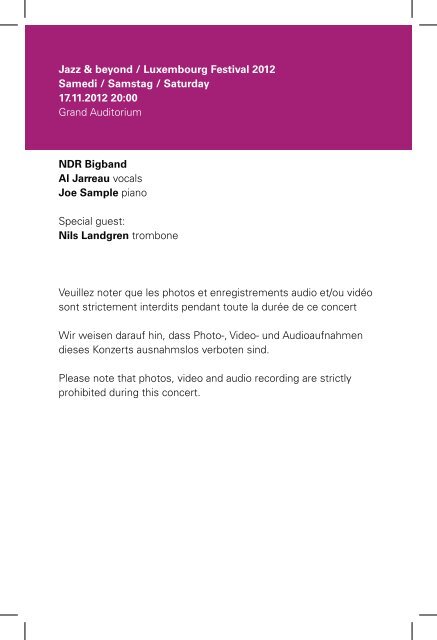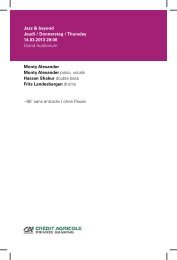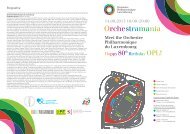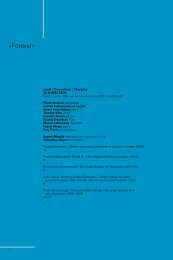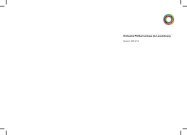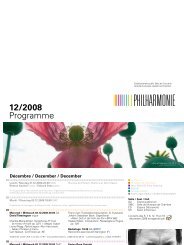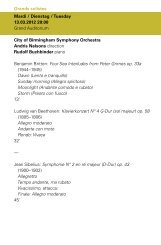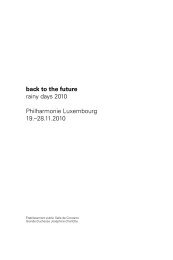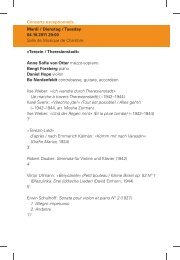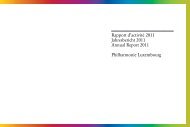NDR Bigband Al Jarreau vocals Joe Sample piano Special guest ...
NDR Bigband Al Jarreau vocals Joe Sample piano Special guest ...
NDR Bigband Al Jarreau vocals Joe Sample piano Special guest ...
Create successful ePaper yourself
Turn your PDF publications into a flip-book with our unique Google optimized e-Paper software.
Jazz & beyond / Luxembourg Festival 2012<br />
Samedi / Samstag / Saturday<br />
17.11.2012 20:00<br />
Grand Auditorium<br />
<strong>NDR</strong> <strong>Bigband</strong><br />
<strong>Al</strong> <strong>Jarreau</strong> <strong>vocals</strong><br />
<strong>Joe</strong> <strong>Sample</strong> <strong>piano</strong><br />
<strong>Special</strong> <strong>guest</strong>:<br />
Nils Landgren trombone<br />
Veuillez noter que les photos et enregistrements audio et/ou vidéo<br />
sont strictement interdits pendant toute la durée de ce concert<br />
Wir weisen darauf hin, dass Photo-, Video- und Audioaufnahmen<br />
dieses Konzerts ausnahmslos verboten sind.<br />
Please note that photos, video and audio recording are strictly<br />
prohibited during this concert.
1 st part<br />
<strong>NDR</strong> <strong>Bigband</strong> feat. <strong>Joe</strong> <strong>Sample</strong><br />
<strong>Joe</strong> <strong>Sample</strong>: Children of the Sun<br />
(2011, arr. Jörg Achim Keller, extracts)<br />
~50’<br />
—<br />
2 nd part<br />
<strong>NDR</strong> <strong>Bigband</strong> feat. <strong>Al</strong> <strong>Jarreau</strong><br />
George Gershwin: Porgy and Bess (1935, extracts)<br />
Compositions by <strong>Al</strong> <strong>Jarreau</strong><br />
~70’<br />
Dans le cadre de Luxembourg Festival
Porgy and Bess in the Sun<br />
Le <strong>NDR</strong> <strong>Bigband</strong> rencontre <strong>Joe</strong> <strong>Sample</strong> et <strong>Al</strong> <strong>Jarreau</strong><br />
Philippe Gonin<br />
Il est une chose indéniable: seul le jazz sait mettre en œuvre des<br />
collaborations artistiques qui, souvent, sont le fruit d’amitiés<br />
fortes. Se forgent ainsi, d’un projet à l’autre, de véritables familles,<br />
où les mêmes musiciens deviennent tour à tour leader ou side-<br />
men, producteurs ou commanditaires. Ces amitiés tournent par-<br />
fois autour d’un ensemble ou d’un artiste dont l’aura agit comme<br />
un véritable catalyseur. Ce catalyseur, ce soir, existe; son ombre<br />
portée va planer au-dessus d’une bonne partie de ce concert et<br />
cet homme, c’est Nils Landgren.<br />
Le tout nouveau directeur du festival Jazz Baltica n’est en effet<br />
pas innocent dans ce projet réunissant le <strong>NDR</strong> <strong>Bigband</strong> et <strong>Joe</strong><br />
<strong>Sample</strong>. On connaît l’attirance de l’ensemble pour les collabora-<br />
tions et on a pu le voir accompagné de Quincy Jones, Steffano<br />
Bollani ou João Bosco. L’on vit même Landgren aux côtés de<br />
l’ensemble lors du Jazz Baltica 2007 réunissant le <strong>NDR</strong> et le bat-<br />
teur Wolfgang Haffner – par ailleurs batteur du Funk Unit dirigé<br />
par le tromboniste (voir le «Licence to Funk» de 2007) - autour<br />
du projet Nordic Shapes. Le Funk Unit joua avec le Big Band en<br />
2010 dans ce même Festival, tandis que Landgren se produisait<br />
récemment encore avec l’ensemble lors de la création du projet<br />
«saveurs chinoises» mêlant instrument traditionnel chinois – Ma<br />
Xiaohui jouant de l’erhu, vielle chinoise à deux cordes – et en-<br />
semble jazz.<br />
3
4<br />
photo: Steven Haberland<br />
Nils Landgren<br />
Amitié fructueuse donc que l’on retrouve entre <strong>Joe</strong> <strong>Sample</strong> et<br />
le tromboniste. L’ex leader des Crusaders (ceux-là même qui, au<br />
milieu des années 1970 connurent les sommets des charts avec<br />
un Street Life auquel Randy Crawford prêta sa voix et dont Taran-<br />
tino se servit dans son «Jackie Brown») et Landgren se connaissent<br />
en fait depuis près de vingt ans: depuis cette séance studio des<br />
Crusaders à Los Angeles dans laquelle l’homme au trombone<br />
rouge s’est retrouvé presque par hasard avant d’accompagner la<br />
formation de <strong>Sample</strong> – Randy Crawford se trouvait également<br />
là – pour un concert à Santa Barbara. En 2003, <strong>Sample</strong> invita<br />
Landgren à suivre les Crusaders reformés pour une tournée au<br />
Japon. C’est presque naturellement que les deux hommes enregistrèrent<br />
en 2006 un bel album (paru chez ACT), «Creole Love<br />
Call», enregistré à la Nouvelle Orléans et auquel participèrent une<br />
pléiade d’invités, presque tous musiciens de la Nouvelle Orléans,
à la seule exception peut-être de Ray Parker Jr, venu du monde<br />
de la pop – il fut l’interprète de la chanson titre du film Ghostbusters<br />
au milieu des années 1980. On peut retenir entre autres une sym-<br />
pathique version de «Sittin’ on the dock of Bay» ou «Nightlife» ainsi<br />
que les titres aux sonorités plus typiquement New Orleans qui<br />
clôturent l’album (dont le titre éponyme signé Ellington). L’album<br />
était déjà produit par Landgren.<br />
Pour couronner le tout, le dernier album studio en date du trom-<br />
boniste («The Moon, The Stars and You», ACT 2011) fait appel<br />
en sideman à… <strong>Joe</strong> <strong>Sample</strong> (<strong>Joe</strong>’s Moonblues) et Steve Gadd. Le<br />
<strong>NDR</strong> participe à la fête sur un titre (The Moon’s A Harsh Mistress,<br />
l’ensemble étant dirigé par Wolf Kerschack) et l’on remarque la<br />
présence dans Holojotes du brésilien João Bosco qui se produisit<br />
avec le <strong>NDR</strong> au Jazz Baltica 2011 (des extraits de cette prestation<br />
sont visibles sur youtube.). La boucle est ainsi bouclée.<br />
«Children of the Sun»:<br />
un concept autour de l’esclavage et de la liberté.<br />
C’est Landgren qui incita le <strong>NDR</strong> à travailler avec <strong>Joe</strong> <strong>Sample</strong> sur<br />
ce concept que le pianiste avait en tête depuis près de vingt ans<br />
et dont on entendra ce soir de larges extraits. Si nous ne savons<br />
pas, à l’heure où nous écrivons, lesquels des onze titres qui com-<br />
posent cette œuvre seront joués, l’auditeur pourra le cas échéant<br />
se rendre compte de ce que donne l’œuvre dans son entier en se<br />
rendant sur youtube où l’on peut voir – en bonne qualité image<br />
et son – l’intégralité de la première mondiale filmée il y a plus<br />
d’un an maintenant au festival Jazz Baltica. Le tromboniste y ap-<br />
paraissait en <strong>guest</strong> star.<br />
«Children of The Sun» est donc un projet ambitieux qui connut<br />
une lente maturation. On trouve en effet trace de celui-ci dès<br />
1994 puisque dans un article publié sur le net daté du 2 décembre<br />
1994, le pianiste annonce que le thème de son prochain<br />
album évoquera ses «impressions sur les émotions engendrées<br />
par l’esclavage et la liberté et sera appelé ‹Children of The Sun›».<br />
L’inspiration lui est venue lors de son passage aux Îles Vierges –<br />
plus précisément à Sainte-Croix – pour un festival de jazz… Au<br />
5
6<br />
milieu des plantations de cannes à sucre et des ruines d’anciennes<br />
distilleries – l’île est réputée pour son rhum et cette tradition per-<br />
dure aujourd’hui encore – lui est venue l’idée d’évoquer ces es-<br />
claves, travaillant la canne à sucre, prisonniers d’une île entourée<br />
par l’océan … Sur le site du big band, <strong>Joe</strong> <strong>Sample</strong> explique encore:<br />
« Pendant des siècles, les colonialistes européens se sont livré des<br />
batailles autour de ces îles» (découverte par Christophe Colomb<br />
qui appela l’île «Santa Cruz», elle fut successivement une posses-<br />
sion hollandaise, anglaise, espagnole, française, danoise et enfin<br />
américaine). «Les esclaves, poursuit le pianiste, étaient considérés<br />
comme des animaux […]. Les Français les appelaient ‹Créoles›,<br />
les Portugais et les Espagnols ‹Crillo› […] Je crois, ces gens se<br />
sont imaginés les ailes avec lesquelles leurs enfants pourraient<br />
voler vers la liberté.» «<strong>Joe</strong> connaît très bien les histoires du temps<br />
des esclaves et sait comment on peut les raconter en musique»,<br />
explique Landgren. «Il peint simplement des images de sa vie,<br />
comme Noir, comme Créole mais aussi comme la personne fan-<br />
tastique qu’il est.»<br />
Musicalement, «Children of The Sun», paré des arrangements or-<br />
chestraux de Jörg Achim Keller, a des couleurs funky et même un<br />
brin latino, rappelant les années 1970 et les grandes années des<br />
Crusaders ou des films américains de cette glorieuse époque. Land-<br />
gren est d’ailleurs fier de son ‹coup›, déclarant: «Les deux musi-<br />
ciens (<strong>Sample</strong> et Keller) ont merveilleusement collaboré» et sou-<br />
lignant la richesse orchestrale des timbres et le ‹groove› de cette<br />
musique.<br />
Un album doit bientôt voir le jour. Landgren, sur son site, annonce<br />
qu’il en est également le producteur. On pourra entendre notam-<br />
ment Steve Gadd à la batterie et les arrangements sont signés…<br />
Jorg Achim Keller, actuel leader du <strong>NDR</strong> <strong>Bigband</strong>.<br />
Une rencontre, deux stars, un même combat.<br />
Ce n’est pas Landgren qui est au centre de la rencontre entre le<br />
<strong>NDR</strong> <strong>Bigband</strong> et <strong>Al</strong> <strong>Jarreau</strong> mais George Gershwin. C’est en effet<br />
autour de la figure emblématique du compositeur de Rhapsody<br />
in Blue que se sont réunis pour la première fois l’ensemble et le
8<br />
George Gershwin, vers 1930<br />
chanteur. Non que ce dernier n’ait pas déjà abordé l’histoire de<br />
Porgy and Bess puisque l’on peut déjà entendre sur ce très bel album<br />
de 1994 – qui comporte quelques autres belles reprises de thèmes<br />
connus (tels que My Favorite Things ou Mas Que Nada), mêlées<br />
à son propre répertoire ou des reprises ‹pop› – Your Song d’Elton<br />
John et She’s Leaving Home des Beatles – une version funky de<br />
Summertime, sortant de l’habituel arrangement de type ballade. Il<br />
faut noter que si <strong>Al</strong> <strong>Jarreau</strong> et <strong>Joe</strong> <strong>Sample</strong> n’ont pas été aussi fré-<br />
quemment réunis que le pianiste le fut avec Landgren, c’est bien<br />
l’ex-leader des Crusaders que l’on retrouve aux crédits de ce «Ten-<br />
derness» ainsi que Steve Gadd et Marcus Miller dont la route avait<br />
déjà croisé celle de <strong>Joe</strong> <strong>Sample</strong> sur l’un des derniers albums de<br />
Miles Davis, «Amandla».<br />
En 1998, année marquant le centenaire de la naissance de Gershwin<br />
(1898–1937), le <strong>NDR</strong> <strong>Bigband</strong> proposait, déjà avec <strong>Al</strong> <strong>Jarreau</strong>,<br />
une nouvelle version du chef d’œuvre du compositeur américain
éarrangé par le pianiste anglais Steve Gray – qui travailla avec<br />
le <strong>NDR</strong> dès 1991, Gray est prématurément décédé en 2008. Neuf<br />
années plus tard, le 27 novembre 2007, c’était au tour du Palais<br />
des Congrès de Paris d’accueillir en première européenne un spec-<br />
tacle intitulé «Porgy & Bess project & Favorite Songs», spectacle<br />
conçu par <strong>Al</strong> <strong>Jarreau</strong>, accompagné par le <strong>NDR</strong> <strong>Bigband</strong> (on peut<br />
en voir un bref extrait sur youtube, de qualité moyenne puisque<br />
filmé depuis le public, avec cet autre titre majeur de l’opéra: It<br />
Ain’t Necessarily So). A l’issue de la représentation parisienne de<br />
2007, <strong>Jarreau</strong> déclarait: «Ma principale contribution à la musique<br />
aura été d’introduire la rythmique dans le registre vocal.» Cela<br />
est vrai, mais il reste aussi l’un des interprètes les plus sensibles<br />
qui soit et sa voix, alors qu’il est âgé aujourd’hui de 72 ans, est<br />
toujours aussi présente et captivante.<br />
Une soirée de groove et d’émotion…<br />
On ne peut que saluer la cohérence d’un tel programme, réunissant<br />
non seulement deux figures charismatiques sur une même scène<br />
mais aussi deux œuvres qui toutes deux traitent d’un même sujet.<br />
«Certains livres ont le pouvoir de changer le monde, était-il écrit<br />
sur le flyer du concert parisien de 2007. Lorsque George Gershwin<br />
posa la main sur la nouvelle Porgy, il en fut fasciné dès la première<br />
page. La même nuit, il écrivit une lettre à l’auteur, comprenant<br />
des plans pour un opéra. La première représentation de Porgy and<br />
Bess neuf ans plus tard à New York créa un véritable scandale:<br />
tous les rôles étaient joués et chantés par des personnes de couleur.»<br />
Depuis, si l’opéra a gagné ses galons et est sans doute l’une des<br />
toutes meilleures œuvres du répertoire américain du 20 e siècle,<br />
ce qu’elle dénonce hélas est toujours d’actualité. Les leçons de<br />
l’Histoire étant insuffisantes, il est bon que l’art, la musique, don-<br />
nent l’opportunité de se souvenir de certaines choses. Surtout<br />
quand, en sus, <strong>Joe</strong> <strong>Sample</strong> nous offre avec «Children of The Sun»<br />
l’une de ses toutes meilleures œuvres. Le concert de ce soir, réu-<br />
nissant sur scène deux stars avec l’une des toutes meilleures for-<br />
mations du genre, donnera à coup sûr naissance à de vraies émo-<br />
tions musicales.<br />
11
12<br />
Großes Kino<br />
<strong>Joe</strong> <strong>Sample</strong>, <strong>Al</strong> <strong>Jarreau</strong> & <strong>NDR</strong> <strong>Bigband</strong><br />
Ralf Dombrowski<br />
In Sachen Big Band hat Deutschland einen Joker im Ärmel. Denn<br />
durch die föderale Struktur des Rundfunkwesens, die jedem Bun-<br />
desland eigene Radioanstalten zubilligt, hat sich über die Jahr-<br />
zehnte die komfortable Situation ergeben, dass sich vier Sender<br />
eigene Jazzorchester leisten. Eines davon ist die <strong>Bigband</strong> des Nord-<br />
deutschen Rundfunks (<strong>NDR</strong>), deren Wurzeln bis zu dem unmittel-<br />
bar nach dem Zweiten Weltkrieg im Mai 1945 gegründeten Radio-<br />
Tanzorchester Hamburg zurückreichen. Zunächst als Unterhaltungs-<br />
ensemble gedacht, entwickelte das Orchester von 1948 an unter<br />
der Leitung des Kölners Franz Thon ein eigenes Profil, das neben<br />
dem Schwofen auch ein wenig Jazz ins Programm brachte. Seit<br />
den 1960er Jahren mehrten sich solche Projekte, die zuweilen<br />
unter dem Signum «<strong>NDR</strong>-Studioband» firmierten. Im darauffol-<br />
genden Jahrzehnt schließlich wurde aus dem Tanzorchester unter<br />
dem Einfluss von Redakteuren wie Wolfgang Kunert eine echte<br />
<strong>Bigband</strong>. <strong>Al</strong>s dann 1980 der vormalige Pianist des Ensembles<br />
Dieter Glawischnig die Leitung übernahm, waren die Weichen<br />
in Richtung jazzende Eigenständigkeit gestellt, eingeleitet und<br />
verdeutlicht durch den Auftritt 1982 beim Jazzfest Berlin zusam-<br />
men mit Gastsolist Benny Wallace. Seitdem hat die <strong>NDR</strong> <strong>Bigband</strong><br />
zahlreiche Projekte mit Gästen wie Carla Bley, Colin Towns,<br />
Michael Gibbs, George Gruntz, João Bosco oder unlängst erst<br />
Quincy Jones verwirklicht, die das internationale Renommee<br />
des seit 2008 von Jörg Achim Keller geleiteten Klangkörpers souve-<br />
rän gemehrt haben.
<strong>Joe</strong> <strong>Sample</strong><br />
<strong>Joe</strong> <strong>Sample</strong><br />
Es gehört zum Konzept der <strong>NDR</strong> <strong>Bigband</strong>, dass das Ensemble<br />
nicht nur in Hamburg seine Programme vorstellt, sondern sich<br />
mit den Gästen und Solisten auch gemeinsam auf den Weg macht.<br />
Diesmal sind zwei Star des amerikanischen Jazz mit im Boot, die<br />
sehr unterschiedliche Ideen an das Orchester herantragen: der<br />
Pianist <strong>Joe</strong> <strong>Sample</strong> und der Sänger <strong>Al</strong> <strong>Jarreau</strong>. <strong>Joe</strong> <strong>Sample</strong> ist einer<br />
der Musiker des Jazz, der im Hintergrund der großen Namen<br />
sich seinen eigenen Kosmos geschaffen hat. Bekannt wurde der<br />
inzwischen 73-jährige Pianist und Komponist aus Houston (Texas)<br />
durch die Jazz Crusaders, eine Band, mit der er zwischen 1961<br />
und 1993 insgesamt 53 <strong>Al</strong>ben veröffentlichte und die es 1979 mit<br />
«Street Life» und Sängerin Randy Crawford sogar an die Spitze<br />
der Hitparaden schaffte.<br />
13
14<br />
Groß geworden im Umfeld der kreolischen Kultur, des frühen<br />
Jazz und Rhythm & Blues, gehörten Blues und Gospel von Anfang<br />
an zu <strong>Joe</strong> <strong>Sample</strong>s Einflüssen, später gefolgt von Soul, Rockjazz,<br />
Fusion und zahlreichen Pop-Elementen, die er als Studiomusiker<br />
im Line-up von Diana Ross, den Jackson Five, Marvin Gaye oder<br />
auch Steely Dan einsetzte. Er gilt als Koryphäe des elektrischen<br />
Fender Rhodes und hat erst vor wenigen Jahren die Big Band als<br />
Klangkörper für sich entdeckt. «Schon als junger Klavierschüler mit<br />
sechs Jahren habe ich davon geträumt, dass es irgendwo eine Welt voll<br />
wunderbarer Klaviere geben muss, die ich dann spielen würde, wenn ich<br />
einmal ein gewisses Stadium der Professionalität erreicht habe. Dann<br />
musste ich aber feststellen, dass das schlechteste Leben als Musiker eigent-<br />
lich das des Pianisten ist, der sich mit jeder Krücke zufrieden geben muss,<br />
die er am Ende des Tages vorfindet. Ich war ja schon froh, als das Fender<br />
Rhodes erfunden wurde. Aber Big Band, das ist noch einmal eine ganz<br />
eigene Stimme. Sie bringt die Kraft der Orchestrierung, die das Klavier<br />
hat, in die Welt der Instrumente, und ich habe mich sofort in diese Kraft<br />
verliebt.»<br />
Im Jahr 2008 nun fragte der Posaunist Nils Landgren, der als künst-<br />
lerischer Berater der <strong>NDR</strong> <strong>Bigband</strong> fungiert, seinen alten Freund<br />
<strong>Sample</strong>, ob er ein Programm für das Orchester gestalten wolle.<br />
Das war die Chance für das Projekt «Children Of The Sun» als<br />
Widmung an die Menschen der Jungferninseln, das bereits seit<br />
mehr als einem Jahrzehnt in der Schublade auf die passende Be-<br />
setzung wartete: «Ich wollte keine typische Big-Band-Musik schreiben.<br />
Davon hat die Welt genug, da muss ich nichts mehr hinzufügen. Nils<br />
Landgren meinte, das wolle er auch gar nicht. Ich solle meine Musik schrei-<br />
ben und die Big Band würde sie dann spielen. Da war mit klar, dass ich<br />
nun die Möglichkeit hatte, das Konzept von ‹Children Of The Sun› wirk-<br />
lich durchzuführen und im großen Rahmen zu erforschen. Ich wusste,<br />
dass ich die perfekte Situation hatte: Eine hochprofessionelle, durchorgani-<br />
sierte Big Band mit Musikern, die sich kennen, miteinander fühlen.»<br />
<strong>Al</strong> <strong>Jarreau</strong><br />
Das Resultat dieser Zusammenarbeit ist vor Kurzem als eigenes<br />
<strong>Al</strong>bum erschienen. Es wird eine der Grundlagen des Konzerts<br />
sein, das aber durch den zweiten Stargast noch in viele andere
<strong>Al</strong> <strong>Jarreau</strong><br />
Richtungen weist. Denn neben Tastenmeister <strong>Joe</strong> <strong>Sample</strong> ist <strong>Al</strong><br />
<strong>Jarreau</strong> mit auf Tournee, der stilistisch folgenreichste Sänger der<br />
vergangenen Jahrzehnte, dessen Karriere zunächst aber nur zöger-<br />
lich Gestalt annahm. Geboren wurde <strong>Al</strong> <strong>Jarreau</strong> im März 1940 in<br />
Milwaukee (Wisconsin), weitab von den amerikanischen Zentren<br />
der Musik. Der Vater war Pfarrer, die Mutter Pianistin. Und der<br />
kleine <strong>Al</strong> trällerte ganz ordentlich vor sich hin, sang in Vocal<br />
Groups im Stil von Lambert, Hendricks & Ross, traute sich aber<br />
den Sprung in die Musikerkarriere nicht zu.<br />
<strong>Al</strong>so studierte <strong>Al</strong> <strong>Jarreau</strong> Psychologie, arbeitete als Rehabilitations-<br />
helfer, jammte gelegentlich mit George Duke und blieb ansonsten<br />
weitgehend erfolglos, bis sich Mitte der 1970er Jahre der allgemeine<br />
Geschmack des Publikums änderte. <strong>Al</strong> <strong>Jarreau</strong>s bis dahin unüb-<br />
liche Symbiose aus Soulgesang, Funkyness, Improvisation und<br />
Entertainment kam plötzlich an. Charakteristisch war das nasale<br />
Timbre seiner Stimme, verbunden mit großer Kraft auch in hohen<br />
Lagen. <strong>Jarreau</strong> erweiterte den wortlosen Scatgesang um Nebenge-<br />
räusche der Stimme wie Atmen, um raues Krächzen und Mund-<br />
Percussion, konnte aber ebenso makellos artikulieren. Das war<br />
der Souljazz-Sound der Stunde, mit «Glow» (1976) in einem<br />
Meisterwerk verewigt, dann zunehmend mit Studioästhetik kan-<br />
diert bis hin zu seinem erfolgreichsten <strong>Al</strong>bum «Breakin’ Away»<br />
(1981).<br />
Seitdem ist <strong>Al</strong> <strong>Jarreau</strong> tonangebend in der internationalen vokalen<br />
Jazzwelt, neben Bobby McFerrin die Autorität in großen Hallen.<br />
Und auch er hat eben erst eine Orchesterplatte veröffentlicht, die<br />
15
live zusammen mit dem holländischen Metropole Orkest unter<br />
der Leitung von Vince Mendoza aufgenommen wurde. Es sind<br />
viele bekannte Stücke seines Repertoires in ungewöhnlichem<br />
Klanggewand zu hören und das ist eine der weiteren Säulen, wo-<br />
rauf das gemeinsame Programm mit <strong>Joe</strong> <strong>Sample</strong> und der <strong>NDR</strong><br />
<strong>Bigband</strong> aufbauen kann. Gemäß seinem Credo, «dass man bereits<br />
existierende Musik neu erfinden, neu beleben und restaurieren<br />
kann und sie vollkommen zeitgenössisch klingen kann» (<strong>Al</strong> <strong>Jarreau</strong>),<br />
wird er auch in dieser Besetzung sich musikalisch nur wenig vorschreiben<br />
lassen. Das Repertoire hat er über die Jahrzehnte hin-<br />
weg verinnerlich, die Freiheit in der Gestaltung aber nie verloren.<br />
Und so stehen die Chancen gut, dass <strong>Al</strong> <strong>Jarreau</strong> gemeinsam mit<br />
einem der soulig lässigsten Pianisten und einem der besten Jazzorchester<br />
dieser Tage zur Hochform aufläuft.<br />
17
18<br />
Interprètes<br />
Biographies<br />
IIIIIIIIIIIIIIIIIIIIIIIIIIIIIIIIIIIIIIIIIIIIIIIIIIIIIIIIIIIIIIIIIIIIIIIIIIIIIIIIIIIIIIIIIIIIIIII<br />
<strong>NDR</strong> <strong>Bigband</strong><br />
Hunter in the morning, shepherd at noontime, critic of an eve-<br />
ning. Elegant swing yesterday, elastic Latin beats today, genuine<br />
bebob tomorrow, and the following day a programme that is so<br />
individual it can only be associated with the <strong>NDR</strong> <strong>Bigband</strong>, a<br />
jazz band made up of self-assured soloists and proud not to be<br />
dependent on the glamour of <strong>guest</strong> stars. Yet, as numerous<br />
meetings with such artists as Chet Baker, Abdullah Ibrahim, <strong>Al</strong><br />
<strong>Jarreau</strong>, Carla Bley, Bobby McFerrin, João Bosco, Omar Sosa and<br />
recently with <strong>Joe</strong> <strong>Sample</strong> clearly demonstrate, the band shuns<br />
neither glamour nor international <strong>guest</strong> stars. Nevertheless, de-<br />
spite all these meetings and their cultivation of the traditional<br />
bigband repertoire within the context of their busy concert sched-<br />
ule within the <strong>NDR</strong>’s transmission area, consistent work on<br />
their own sound remains their core area of competence and<br />
constitutes what makes the <strong>NDR</strong> <strong>Bigband</strong> uniquely attractive –<br />
precisely what editor Wolfgang Kunert and long-standing leader<br />
Dieter Glawischnig had in mind some thirtyfive years ago when<br />
they set about redefining the function of this band. As a conse-<br />
quence, the <strong>NDR</strong> <strong>Bigband</strong> has gained a reputation as one of jazz’s<br />
foremost bigbands on both sides of the Atlantic, a winning con-<br />
cept that has been faithfully pursued for the last three years<br />
under the artistic direction of Jörg Achim Keller. Just as unmistak-<br />
ably as Keller, who, born in Zurich in 1966, was writing arrange-<br />
ments for the <strong>NDR</strong> <strong>Bigband</strong> at the tender age of 20, represents<br />
a younger generation of bandleaders, so clearly, too, is the un-<br />
changing three-part structure of the band’s repertoire. The first
<strong>NDR</strong> <strong>Bigband</strong><br />
part consists in preserving jazz’s century-old tradition, the second<br />
in exciting meetings with such stars as Bobby McFerrin, Maria<br />
Schneider or Rolf Kühn, and the third in honing their own profile<br />
by performing compositions either by members of the band or<br />
ones written by the bandleader. This top-rank Hamburg jazz en-<br />
semble offers its soaring flights of musical artistry in programmes<br />
tailor-made for the soloists in the band by arrangers such as the<br />
late Steve Gray, fellow Briton Colin Towns or Michael Gibbs. And<br />
this is where the <strong>NDR</strong> <strong>Bigband</strong> comes into its own, versed, as<br />
it is, in each and every stylistic register, yet with its feet firmly<br />
planted in the here and now. And that’s what sets this bigband<br />
apart from the others. After traditional radio entertainment, prime-<br />
time TV shows and everyday light music had been left behind,<br />
there remained behind the desks of the <strong>NDR</strong> <strong>Bigband</strong> just those<br />
resolute jazz musicians with the determination, courage and<br />
ability to play after their very own fashion. From long-standing<br />
lead sax Herb Geller, who won his spurs as one of the insiders<br />
in the cool West Coast scene, to the gifted Wolfgang Schlüter,<br />
his opposite number on the fragile vibraphone, to today’s mem-<br />
bers, the Frankfurt rhapsodist Christof Lauer and unassuming<br />
tonal aesthete Lutz Büchner on tenor saxophones, together<br />
with abstract expressionist Peter Bolte and rocker Fiete Felsch<br />
on altos as well as powerplant Frank Delle out on the right on<br />
baritone sax. From section leader Thorsten Benkenstein and the<br />
Hunter in the morning, shepherd at noontime, critic of an evening.<br />
Elegant swing yesterday, elastic Latin beats today, genuine be-<br />
photo: Steven Haberland<br />
19
20<br />
bob tomorrow, and the following day a programme that is so in-<br />
dividual it can only be associated with the <strong>NDR</strong> <strong>Bigband</strong>, a jazz<br />
band made up of self-assured soloists and proud not to be de-<br />
pendent on the glamour of <strong>guest</strong> stars. Yet, as numerous meetings<br />
with such artists as Chet Baker, Abdullah Ibrahim, <strong>Al</strong> <strong>Jarreau</strong>,<br />
Carla Bley, Bobby McFerrin, João Bosco, Omar Sosa and recently<br />
with <strong>Joe</strong> <strong>Sample</strong> clearly demonstrate, the band shuns neither<br />
glamour nor international <strong>guest</strong> stars. Nevertheless, despite all<br />
these meetings and their cultivation of the traditional bigband<br />
repertoire within the context of their busy concert schedule with-<br />
in the <strong>NDR</strong>’s transmission area, consistent work on their own<br />
sound remains their core area of competence and constitutes<br />
what makes the <strong>NDR</strong> <strong>Bigband</strong> uniquely attractive – precisely<br />
what editor Wolfgang Kunert and long-standing leader Dieter<br />
Glawischnig had in mind some thirtyfive years ago when they<br />
set about redefining the function of this band. As a consequence,<br />
the <strong>NDR</strong> <strong>Bigband</strong> has gained a reputation as one of jazz’s fore-<br />
most bigbands on both sides of the Atlantic, a winning concept<br />
that has been faithfully pursued for the last three years under the<br />
artistic direction of Jörg Achim Keller. Just as unmistakably as<br />
Keller, who, born in Zurich in 1966, was writing arrangements<br />
for the <strong>NDR</strong> <strong>Bigband</strong> at the tender age of 20, represents a younger<br />
generation of bandleaders, so clearly, too, is the unchanging<br />
three-part structure of the band’s repertoire. The first part consists<br />
in preserving jazz’s century-old tradition, the second in exciting<br />
meetings with such stars as Bobby McFerrin, Maria Schneider<br />
or Rolf Kühn, and the third in honing their own profile by perform-<br />
ing compositions either by members of the band or ones writ-<br />
ten by the bandleader. This top-rank Hamburg jazz ensemble<br />
offers its soaring flights of musical artistry in programmes tailor-<br />
made for the soloists in the band by arrangers such as the late<br />
Steve Gray, fellow Briton Colin Towns or Michael Gibbs. And this<br />
is where the <strong>NDR</strong> <strong>Bigband</strong> comes into its own, versed, as it is,<br />
in each and every stylistic register, yet with its feet firmly plan-<br />
ted in the here and now. And that’s what sets this big band apart<br />
from the others. After traditional radio entertainment, prime-<br />
time TV shows and everyday light music had been left behind,<br />
there remained behind the desks of the <strong>NDR</strong> <strong>Bigband</strong> just those
esolute jazz musicians with the determination, courage and<br />
ability to play after their very own fashion. From long-standing<br />
lead sax Herb Geller, who won his spurs as one of the insiders<br />
in the cool West Coast scene, to the gifted Wolfgang Schlüter,<br />
his opposite number on the fragile vibraphone, to today’s mem-<br />
bers, the Frankfurt rhapsodist Christof Lauer and unassuming<br />
tonal aesthete Lutz Büchner on tenor saxophones, together with<br />
abstract expressionist Peter Bolte and rocker Fiete Felsch on<br />
altos as well as powerplant Frank Delle out on the right on bari-<br />
tone sax. From section leader Thorsten Benkenstein and the<br />
manifoldly well-versed Claus Stötter to sound-modeller Ingolf<br />
Burkhardt and free-thinking avant-gardist Reiner Winterschladen<br />
on trumpets. From Stefan Lottermann, who contributes a whiff<br />
of that cool Frankfurt enjoyment of experimentation, to vitality<br />
breathing Dan Gottshall and Ingo Lahme on trombones. From<br />
Argentinian-born percussionist Marcio Doctor and studio wizard<br />
Stephan Diez on guitar to keyboarder Vladyslav Sendecki, who<br />
not only knows all a concert pianist’s tricks but who not so long<br />
ago was presented with the Hamburg Jazz Award. And, most<br />
recently, the young trombonist Klaus Heidenreich and double<br />
bassist Ingmar Heller have joined the band – each musician con-<br />
tributing his very own splash of colour to the whole and, in so<br />
doing, pushing the ensemble’s horizon ever further out. As well<br />
as adding to the friction within the band, that very friction which<br />
makes for the fiery vitality that has become the trademark of the<br />
<strong>NDR</strong> <strong>Bigband</strong>. After all, it’s jazz, music improvised by soloists.<br />
IIIIIIIIIIIIIIIIIIIIIIIIIIIIIIIIIIIIIIIIIIIIIIIIIIIIIIIIIIIIIIIIIIIIIIIIIIIIIIIIIIIIIIIIIIIIIIII<br />
<strong>Al</strong> <strong>Jarreau</strong> <strong>vocals</strong><br />
<strong>Al</strong> <strong>Jarreau</strong>’s unique vocal style is one of the world’s most pre-<br />
cious treasures. His innovative musical expressions have made<br />
him one of the most exciting and critically-acclaimed performers<br />
of our time with seven Grammy Awards, scores of international<br />
music awards and popular accolades worldwide. It’s not surprising<br />
that he has perfected his technique to such an art. After all, he<br />
has been singing since the age of four, harmonizing with his<br />
brothers and performing solo at a variety of local events in his<br />
hometown of Milwaukee, Wisconsin. Music, however, was not<br />
23
24<br />
<strong>Al</strong> <strong>Jarreau</strong><br />
always the major force in his life. He excelled in sports and was<br />
an above-average student throughout high school and college.<br />
Enrolling at the respected Ripon College in Wisconsin, <strong>Jarreau</strong><br />
continued singing for fun, performing locally with a group called<br />
The Indigos during weekends and holidays, and graduated with<br />
a Bachelor of Science degree in Psychology. After moving on to<br />
the University of Iowa to earn his Master’s Degree in Vocational<br />
Rehabilitation, <strong>Jarreau</strong> subsequently relocated to San Francisco<br />
to begin a career in rehabilitation counseling. In San Francisco,<br />
<strong>Al</strong>’s natural musical gifts began to shape his future. He found<br />
himself performing at a small jazz club with a trio headed by<br />
George Duke, and by the late 1960s, he knew without a doubt<br />
that he would make singing his life. Relocating to Los Angeles,<br />
he began his apprenticeship in such famed nightspots as Dino’s,<br />
the Troubadour and the Bitter End West. Shortly thereafter, he<br />
branched out to New York City as well, where he gained national<br />
network television exposure with Johnny Carson, Merv Griffin,<br />
David Frost and Mike Douglas. <strong>Al</strong> teamed with guitarist Julio
Martinez to «spell» up-and-coming comics John Belushi, Bette<br />
Midler, Robert Klein, David Brenner, Jimmie Walker and others<br />
at the famed comedy venue, The Improv. In 1975, following an<br />
extended stint at the Bla Bla Cafe in Los Angeles, he was spotted<br />
by Warner Bros. Records talent scouts and was signed to a re-<br />
cording contract. His debut album for the label, «We Got By»,<br />
was released to unanimous acclaim. It was a reception that<br />
spread across the continent and over the Atlantic when <strong>Jarreau</strong><br />
was awarded a German Grammy for Best New International Solo-<br />
ist that same year. A second German Grammy came his way<br />
with the release of his follow-up album, «Glow». <strong>Al</strong>’s career break-<br />
through came in 1977 when Warner Brothers Records released<br />
«Look» to the Rainbow, his live double album, which was culled<br />
from his first world tour from that same year, and earned the<br />
vocalist his first Grammy for Best Jazz Vocal Performance. His<br />
fourth album, «<strong>Al</strong>l Fly Home», was released in 1978 to further<br />
accolades and a second Grammy for Best Jazz Vocalist. It was<br />
followed by a string of innovative and original offerings, including<br />
1980’s «This Time», and the million-selling «Breakin’ Away», which<br />
brought him a broader audience and two more Grammy’s with<br />
awards for Best Male Pop Vocalist and Best Male Jazz Vocalist.<br />
In 1983 <strong>Jarreau</strong> was released, followed closely the following<br />
year by «High Crime». Both albums spawned a string of R&B<br />
and pop hits, and further cemented him as an international super-<br />
star. «<strong>Al</strong> <strong>Jarreau</strong> – Live in London», recorded before a SRO crowd<br />
at Wembley Arena in 1985, continued to solidify <strong>Jarreau</strong>’s repu-<br />
tation as a world-class master of both studio and stage. Follow-<br />
ing the live album, <strong>Jarreau</strong> teamed with top producer Nile Rodgers<br />
for «L Is For Lover», which brought some new styles and sounds<br />
to the singer’s repertoire. He continued to top the stateside<br />
charts in 1987 and became a weekly <strong>guest</strong> in America’s living<br />
rooms singing the Grammy nominated theme song for the hit<br />
television series Moonlighting. With hardly time to take a breath,<br />
he launched into the recording of the «Heart’s Horizon» album,<br />
which contained the #2 R&B smash «So Good» and earned him<br />
another Grammy nomination, this time for Best R&B <strong>Al</strong>bum.<br />
After touring the globe for nearly two years, he returned to the<br />
studio – this time with Narada Michael Walden – to fashion the<br />
25
26<br />
sound that would launch him into his third decade of music-mak-<br />
ing. The result was 1992’s «Heaven and Earth» for which he<br />
received his fifth Grammy for Best R&B Vocal Performance. With<br />
this, he became one the rare artists to have won Grammy’s in<br />
the three categories of jazz, pop, and R&B. In 1994, «Tenderness»<br />
was released. On this Marcus Miller-produced gem, <strong>Jarreau</strong><br />
is joined by an all-star cast (David Sanborn, Kathleen Battle,<br />
<strong>Joe</strong> <strong>Sample</strong>, Steve Gadd, to name a few) to bring us a host of<br />
familiar contemporary compositions and to revisit a few <strong>Jarreau</strong><br />
classics. 1996 brought some exciting career challenges. While<br />
on a break from touring, <strong>Jarreau</strong> accepted a three-month stint<br />
on Broadway playing the role of Teen Angel in the hit musical<br />
Grease! Other recent credits include <strong>guest</strong> star appearances on<br />
New York Undercover, Touched By An Angel and a national<br />
McDonald’s commercial with R&B sensation, Vesta Williams. In<br />
1999, for the first time, <strong>Al</strong> <strong>Jarreau</strong> teamed up with symphony<br />
orchestras throughout the U.S. and Europe performing his most<br />
popular hits as never heard before as well as some favorites<br />
from Broadway and the Classics, which received outstanding<br />
review. <strong>Al</strong> continues to perform symphony shows on a regular<br />
basis. Called «the voice of versatility» by the Chicago Tribune<br />
and «one of the world’s greatest natural resources» by the Detroit<br />
News, <strong>Jarreau</strong> added a new chapter to his twenty-five-year record-<br />
ing career with «Tomorrow Today» (2001), his GRP Records de-<br />
but. <strong>Al</strong> <strong>Jarreau</strong> received his own Star on the Hollywood Walk of<br />
Fame, in March 2001, commemorating his status as one of the<br />
best singers of his generation. <strong>Al</strong> spent the remainder of 2001<br />
touring the United States, Europe and South Africa and working<br />
on his next album, «<strong>Al</strong>l I Got» (2002), where he teamed up with<br />
Verzion Telecom as a Champion for Literacy. This was followed<br />
on by the Grammy nominated «Accentuate The Positive» (2004)<br />
on GRP Records/Universal Music Group. <strong>Al</strong>’s 30 th year in the<br />
music business saw another landmark with the pairing up with<br />
his peer the legendary R&B guitarist & singer, George Benson,<br />
for the album «Givin’ It Up». Recorded in Spring of 2006, this<br />
record featured many <strong>guest</strong> artists including Herbie Hancock,<br />
Sir Paul McCartney, Jill Scott, Chris Botti and Patti Austin, amongst<br />
others musical veterans. «Givin’ It Up» was released to critical
acclaim on October 24, 2006 by Concord Music Group/Monster<br />
Music and garnered three Grammy nominations for; Best R&B<br />
Vocal Performance by a Duo or Group, for «Breezin» (nomination<br />
only), and two Grammy wins in 2007 Best Traditional R&B Vocal<br />
Performance for «God Bless The Child» feat. Jill Scott, and Best<br />
Pop Instrumental for «Mornin». Early in 2008, <strong>Al</strong> handpicked his<br />
favorite romantic tunes spanning three decades for his «Love<br />
Songs», a 14-track compilation that was released in January 2008<br />
on Rhino/Warner Music Group. He also helped the Playboy Jazz<br />
Festival celebrate its 30-year anniversary by headlining a sold-<br />
out opening night at the Hollywood Bowl in Los Angeles. A few<br />
months later on October 14, 2008, <strong>Al</strong> released his first-ever<br />
Yuletide album, «Christmas». The album features his warm and<br />
inimitable voice interpreting a dozen holiday classics, including<br />
«The Christmas Song», «Winter Wonderland» and «Carol Of The<br />
Bells». Still one of the hardest working men in show business,<br />
2009 saw <strong>Al</strong> take in a six-week European spring tour visiting<br />
theatres & festivals in Germany, France, Scandinavia, Eastern<br />
Europe and North America. In the middle of all this, <strong>Al</strong> also found<br />
the time to put together «The Very Best of <strong>Al</strong> <strong>Jarreau</strong>: An Excellent<br />
Adventure». The 16-song collection highlights some of <strong>Al</strong>’s best-<br />
known songs, alongside one new track «Excellent Adventure»,<br />
which was produced by Richard Nichols and The Randy Watson<br />
Experience (Grammy winning songwriter James Poyser and The<br />
Roots drummer Amir «Questlove» Thompson) – who have also<br />
produced songs for Erykah Badu, <strong>Al</strong> Green and The Roots (among<br />
other notable artists). Some of the albums represented include<br />
1976’s «Glow» («Rainbow In Your Eyes» one of <strong>Al</strong>’s first ever<br />
charting tunes), 1977’s «Look to the Rainbow» («Take Five»),<br />
1980’s «This Time» («Spain», «Never Givin’ Up»), 1981’s «Breakin’<br />
Away» («Roof Garden,» «We’re In This Love Together»), 1983’s<br />
«<strong>Jarreau</strong>» («Mornin’,» «Boogie Down»), 1984’s «High Crime»<br />
(«After <strong>Al</strong>l»), 1988’s «Heart’s Horizon» («So Good») and «Accen-<br />
tuate The Positive» («Cold Duck»), along with other hits «Moon-<br />
lighting», the theme from the hit TV series; Grammy-winning<br />
virtuosic «Round, Round, Round», «Blue Rondo A La Turk», and<br />
«We Got By» (from <strong>Al</strong>’s debut album of the same name). After<br />
more than 30-years <strong>Al</strong> <strong>Jarreau</strong> is undoubtedly one of the greatest<br />
29
30<br />
<strong>Joe</strong> <strong>Sample</strong><br />
performers and innovative vocalists the music world has ever<br />
known. Time Magazine called him «the greatest jazz singer alive»<br />
and «Excellent Adventure» illustrates perfectly the reason why.<br />
<strong>Al</strong> continues to tour extensively worldwide, with his sextet and<br />
Symphony shows, and is currently in studio working on a new<br />
album.<br />
IIIIIIIIIIIIIIIIIIIIIIIIIIIIIIIIIIIIIIIIIIIIIIIIIIIIIIIIIIIIIIIIIIIIIIIIIIIIIIIIIIIIIIIIIIIIIIII<br />
<strong>Joe</strong> <strong>Sample</strong> <strong>piano</strong><br />
For more than four decades, pianist and composer <strong>Joe</strong> <strong>Sample</strong><br />
has been an integral, innovative and bestselling part of jazz his-<br />
tory. With «Soul Shadows», the first all solo <strong>piano</strong> recording of<br />
<strong>Sample</strong>’s illustrious career, he pays homage to the great American<br />
songwriters of the 20 th century whose masterful works inspired<br />
his own development as one of the most diverse and popular<br />
jazz performers of the last half century. A founding member of<br />
the influential jazz funk combo The Crusaders (originally the Jazz<br />
Crusaders) and a pioneer of contemporary jazz <strong>piano</strong>, <strong>Sample</strong><br />
reaches back to the primary sources of jazz and soul music to<br />
create his personal interpretations of classics by such esteemed
composers as Scott Joplin, Jelly Roll Morton, the Gershwins, <strong>Al</strong><br />
Jolson, Duke Ellington, Fats Waller and others. While exploring<br />
these rich expressions of Americana, <strong>Sample</strong> acknowledges his<br />
own key role in carrying on these powerful legacies by including<br />
distinct reworkings of two of his own classics, «Soul Shadows»<br />
(which originally appeared on «The Crusaders’ Midnight Triangle»<br />
in 1976) and «Spellbound». Soul Shadows’ multi-faceted 12 track<br />
set list includes such Great American Songbook chestnuts as<br />
Joplin’s «The Entertainer», Ellington’s «I Got It Bad and That’ Ain’t<br />
Good», Gershwin’s «Embraceable You» and «I Got Rhythm»,<br />
Waller’s «Ain’t Misbehavin’» and «Jitterbug Waltz», Morton’s<br />
«Shreveport Stomp» and Jolson’s «Avalon». But for <strong>Sample</strong>, the<br />
collection is more than simply living and re-interpreting musical<br />
history-it’s a true window into the heart and roots of the man<br />
and an insight into the role of the <strong>piano</strong> player in 20 th Century<br />
American music. His approach to the songs and the genre per-<br />
fectly reflect <strong>Sample</strong>’s belief that «if you played the <strong>piano</strong> in a<br />
stride or ragtime or a boogie-woogie manner, you wouldn’t need<br />
a bass player, you didn’t need a drummer. That’s how I started<br />
playing in the first place. I’ve been a solo pianist since I was six<br />
years old playing in my mama’s living room for her after-church<br />
teas.» Conceptually, the defining track on «Soul Shadows» is<br />
the Walter Donaldson-Sam Lewis-<strong>Joe</strong> Young composition «How<br />
You Gonna Keep ‘Em Down on the Farm?» which opens the<br />
set. For <strong>Sample</strong>, the album is something of a long overdue tribute<br />
to a chief personal influence slightly lesser known to the listening<br />
public-James Reese Europe, the first bona fide jazz big band<br />
leader whose jazz orchestra entered Paris in 1918 as part of the<br />
famous Fighting 369 th unit. Before returning to Harlem in 1919,<br />
Europe and his orchestra spread jazz throughout England and<br />
Europe, introducing audiences to a sound and style that would<br />
change history. <strong>Sample</strong>’s father fought in World War I and told<br />
his son stories about Europe and hearing the song, which was a<br />
big hit during that time. «As a young musician I wondered, where<br />
did our music come from?» says <strong>Sample</strong>. «I’ve become a bit of<br />
a historian of jazz and all African American music, and recently<br />
discovered a biography of James Reese Europe. Reading that<br />
biography has given me a clearer understanding of why he has<br />
31
32<br />
been so important not only to me, but to all of us.» Learning to<br />
play <strong>piano</strong> at age five, the Houston native’s formative years found<br />
him firmly rooted in many different musical traditions, including<br />
gospel, soul, bebop, blues, Latin, and classical music. One of<br />
the many jazzmen who started out playing hard bop but went<br />
electric during the fusion era, (soon after attending Texas Southern<br />
University for three years,) <strong>Sample</strong> founded the Jazz Crusaders<br />
along with trombonist Wayne Henderson, tenor saxman Wilton<br />
Felder and drummer Stix Hooper. Relocating to and launching<br />
their storied career in Los Angeles, The Crusaders patterned<br />
themselves after Art Blakey’s Jazz Messengers, only without a<br />
trumpet and becoming renowned for their unique tenor/trombone<br />
front line. <strong>Sample</strong> focused on the acoustic <strong>piano</strong> during the Cru-<br />
saders’ early years (late 1950s, early 1960s), but began to place<br />
greater emphasis on electric keyboards when the band turned<br />
to jazz/funk in the early 1970s and dropped the «Jazz» from its<br />
name. After garnering numerous gold and platinum albums over<br />
the course of nearly three decades, The Crusaders’ last official<br />
recording was «Life in the Modern World» in 1987. <strong>Sample</strong> and<br />
Felder released the dual album «Healing the Wounds» on GRP<br />
in the early 1990s, and in 2003 rejoined Hooper for a more full-<br />
scale reunion that produced the Southern styled hit jazz fusion<br />
recording Rural Renewal-billed as the first new album by The<br />
Crusaders in over 20 years-and a popular subsequent tour. While<br />
actively touring as a member of the Crusaders, <strong>Sample</strong> simultane-<br />
ously launched a successful solo career. His bestselling recor-<br />
dings include «Rainbow Seeker», «Carmel», «Voices in the Rain»,<br />
«Spellbound», «Ashes to Ashes», «Invitation» (a return to his be-<br />
bop roots), «Did You Feel That?», «Old Places», «Old Faces» and<br />
the George Duke produced «<strong>Sample</strong> This». GRP also released<br />
«The <strong>Joe</strong> <strong>Sample</strong> Collection» and the three CD «Crusaders Collec-<br />
tion» as testament to <strong>Sample</strong>’s enduring legacy. The pianist’s<br />
most recent recordings are 1999’s «The Song Lives On» (featuring<br />
duets with singer Lalah Hathaway) and 2002’s «The Pecan Tree»,<br />
a colorful tribute to his hometown of Houston, where he reloca-<br />
ted in 1994. In addition to his own recording, <strong>Sample</strong> has toured<br />
and performed with numerous musical greats in all genres, includ-<br />
ing Marvin Gaye, Tina Turner, BB King, Eric Clapton, <strong>Joe</strong> Cocker,
Randy Crawford (who sang on the 1979 Crusaders smash «Street<br />
Life»), Anita Baker, Andrae Crouch and many others. By return-<br />
ing to the roots of his own musical influence, <strong>Sample</strong>’s «Soul<br />
Shadows» gives us a unique reflection and chronicle of traditional<br />
American music at its best.<br />
IIIIIIIIIIIIIIIIIIIIIIIIIIIIIIIIIIIIIIIIIIIIIIIIIIIIIIIIIIIIIIIIIIIIIIIIIIIIIIIIIIIIIIIIIIIIIIII<br />
Nils Landgren special <strong>guest</strong><br />
Born in 1956, Nils Landgren began playing drums at the age of<br />
six, before at last discovering the trombone at 13. Between 1972<br />
and 1978 Nils studied classical trombone at the music college<br />
in Karlstad with David Maytan and at the university in Arvika with<br />
Ingemar Roos. Meeting the legendary Swedish Folk-Jazz pioneer<br />
Bengt-Arne Wallin as well as the fantastic trombonist Eje Thelin<br />
persuaded Nils to move from strict classical studies to improvisa-<br />
tion and to begin the development of his own approach. After<br />
his graduation Nils moved to Stockholm to work as a professional<br />
trombone player. He was soon touring with the most successful<br />
Swedish pop star of that time, Björn Skifs’ Blue Swede who<br />
got to number 1 in the US pop charts with Hooked on a feeling.<br />
In 1981 Thad Jones invited the Swede into his new big band<br />
project «Ball of Fire», to take the lead-trombone chair. Ever since<br />
that time Nils Landren has been involved in most styles equally:<br />
jazz and rock, soul and hip hop, big band sessions, and by his<br />
own reckoning, at least 500 albums including such internationals<br />
stars as ABBA, The Crusaders, Eddie Harris, Bernard ‹Pretty›<br />
Purdie, Wyclef Jean and Herbie Hancock. In 1983 Nils’ debut<br />
album «Planet Rock» was released, followed by «Streetfighter»<br />
in 1984, «You are my Nr 1» in 1985, «Miles from Duke» with<br />
Bengt-Arne Wallin in 1987, «Chapter Two 1», in 1987, «Chapter<br />
Two 2» and «Follow your heart» in 1989. Between 1985 and<br />
1987 Nils also performed as actor, singer, trombonist, and dancer<br />
in over 360 performances of the Swedish ‹play of the year›, Skål,<br />
as well as appearing in several TV-films as an actor. 1992 saw<br />
the first performances and recording of the Nils Landgren ‹Unit›.<br />
The final breakthrough beyond Scandinavia came first in 1994:<br />
it was at the Jazz Baltica Festival at Salzau in Germany that the<br />
‹Unit› became the ‹Funk Unit›. The album «Live in Stockholm»<br />
35
36<br />
photo: Steven Haberland<br />
Nils Landgren<br />
was released that year and was the foundation for the collabo-<br />
ration with Siegfried Loch and his then young ACT label. The next<br />
Funk Unit release, «Paint It Blue», was one of 1997's most suc-<br />
cessful albums and received Germany’s Jazz Award. The following<br />
tour of over 100 dates gave Nils Landgren and the Funk Unit<br />
their breakthrough in Germany. Inspired by his mentor Bengt-<br />
Arne Wallin, Nils Landgren ventured into non-funky realms with<br />
a re-working of traditional Swedish folk songs: «Swedish Folk<br />
Modern» (ACT 9257-2), his first duo with the pianist Esbjörn<br />
Svensson, followed up by «Layers of Light», an even gentler<br />
evocation. Between January 1998 and January 2001 Nils Landgren<br />
was also a member of the <strong>NDR</strong> <strong>Bigband</strong> in Hamburg, but con-<br />
tinuously touring throughout with the Funk Unit worldwide. During<br />
this time three albums were released: after «Live in Montreux»<br />
(ACT 9265-2) appeared in 1999 «5000 Miles» and in September<br />
2001 «Fonk da World» (ACT 9299-2), which was presented live<br />
at a special 3 day festival in Hamburg dedicated to Nils Landgren’s
music. The «grooving band, which encouraged the younger mem-<br />
bers of the audience into a dance frenzy, but which was also<br />
taken seriously by the greying jazz snobs» (Der Spiegel), proved<br />
that it could be counted as «the best funk band in Europe today»<br />
(Stereo). As artistic director of the illustrious Berlin Jazz Festival<br />
in 2001 Nils Landgren set up a concise overview of the current<br />
directions in Scandinavian jazz and was awarded the ‹Tore Ehrling<br />
Prize› by the Swedish Composers’ Federation for his «special<br />
contribution in bringing worldwide attention to Swedish jazz». A<br />
further aspect of Landgren’s multi-facetedness has been shown<br />
since 1993, when the album «Ballads» was recorded, and on its<br />
release in Germany in 1999 showed for the first time his talent<br />
as an emotional ballad singer. With his tasteful tenor voice he<br />
has been compared to the introverted style of Chet Baker. In<br />
2002 he undertook a recording of a sequence of love songs on<br />
a «Sentimental Journey» which was enthusiastically received<br />
by public and critics alike. «We want more of this» proclaimed<br />
the WOM Journal and so was able to follow this through the<br />
production of the album «I Will Wait For You» where the singer<br />
Rigmor Gustafsson – having previously made her name as a<br />
<strong>guest</strong> on «Sentimental Journey» – took centre stage. It stormed<br />
into the jazz charts in Sweden and Germany, reaching number<br />
1 and number 2 respectively. In 2004, after a self-imposed sab-<br />
batical of almost two years, Landgren went full steam ahead<br />
with his Funk Unit and produced the acclaimed Platinum «Funky<br />
Abba» album; his own personal hommage to one of the greatest<br />
pop bands in history. 2005 marks the new album «Creole Love<br />
Call» together with the legendary keyboarder <strong>Joe</strong> <strong>Sample</strong> of The<br />
Crusaders, in which Nils Landgren can be heard again primarily<br />
as a vocalist. In December 2005, Nils Landgren celebrated Christ-<br />
mas in a church in Stockholm with some friends from the Scan-<br />
dinavian music scene and thus fulfilling a long-time dream. This<br />
unique recording of the most beautiful Christmas songs from<br />
the middle ages to our time was released in December 2006 on<br />
CD and DVD, went gold in Sweden and Germany within a month<br />
of its release, and climbed to #2 of the German Jazz charts:<br />
«Christmas with my Friends». 2007 brings the Funk Unit back<br />
again. The eighth funk album demonstrates the same killer groove<br />
39
40<br />
as its award-winning predecessors lead us to expect. Nils Land-<br />
gren definitely has it: the «Licence to Funk». Given the resounding<br />
success of JazzFest Berlin ‘01, Landgren has been nominated<br />
again in 2008 as artistic director of the JazzFest Berlin for the<br />
coming three years. At the end of 2008 he will release a sequel<br />
of his successful first Christmas album: «Christmas With My<br />
Friends II». Music knows no borders, music is freedom – this is<br />
Nils Landgren’s credo. For every record of his new Funk Unit<br />
album «Funk For Life» (released in spring 2010) sold, one Euro<br />
goes to the Funk Unit – Médecins Sans Frontières (Doctors with-<br />
out borders) project «Funk For Life» in Kibera Nairobi. By purcha-<br />
sing the CD the buyer will contribute in making life for people<br />
in Kibera just a bit easier. And he helps to guarantee that from<br />
now on, music will be a central part of the education in Kibera.
46<br />
IIIIIIIIIIIIIIIIIIIIIIIIIIIIIIIIIIIIIIIIIIIIIIIIIIIIIIIIIIIIIIIIIIIIIIIIIIIIIIIIIIIIIIII JAZZ & BEYOND<br />
Prochain concert du cycle «Jazz & beyond»<br />
Nächstes Konzert im Zyklus «Jazz & beyond»<br />
Next concert in the cycle «Jazz & beyond»<br />
Option B Mardi / Dienstag / Tuesday 22.01.2013 20:00<br />
Salle de Musique de Chambre<br />
«GismontiPascoal»<br />
Hamilton de Holanda mandolin<br />
André Mehmari <strong>piano</strong><br />
IIIIIIIIIIIIIIIIIIIIIIIIIIIIIIIIIIIIIIIIIIIIIIIIIIIIIIIIIIIIIIIIIIIIIIIIIIIIIIIIIIIIIIIIIIIIIIIIIIIIII<br />
Option C Mardi / Dienstag / Tuesday 26.02.2013 20:00<br />
Salle de Musique de Chambre<br />
Tineke Postma Quartet<br />
Tineke Postma soprano & alto saxophone<br />
Marc van Roon <strong>piano</strong><br />
Frans van der Hoeven bass<br />
Martijn Vink drums<br />
IIIIIIIIIIIIIIIIIIIIIIIIIIIIIIIIIIIIIIIIIIIIIIIIIIIIIIIIIIIIIIIIIIIIIIIIIIIIIIIIIIIIIIIIIIIIIIIIIIIIII<br />
Jeudi / Donnerstag / Thursday 14.03.2013 20:00<br />
Grand Auditorium<br />
Monty <strong>Al</strong>exander Trio<br />
Monty <strong>Al</strong>exander <strong>piano</strong>, <strong>vocals</strong><br />
Lorin Cohen double bass<br />
Frits Landesbergen drums
IIIIIIIIIIIIIIIIIIIIIIIIIIIIIIIIIIIIIIIIIIIIIIIIIIIIIIIIIIIIIIIIIIIIIIIIIIIIIIIII LUXEMBOURG FESTIVAL<br />
Prochain concert «Luxembourg Festival» à la Philharmonie<br />
Nächstes «Luxembourg Festival»-Konzert in der Philharmonie<br />
Next «Luxembourg Festival» concert at the Philharmonie<br />
Dimanche / Sonntag / Sunday 18.11.2012 20:00<br />
Grand Auditorium<br />
«Bach meets Fats Waller»<br />
Nigel Kennedy violin<br />
Jarek Śmietana guitar<br />
Yaron Stavi bass<br />
Krzysztof Dziedzic percussion<br />
Johann Sebastian Bach: Partita N° 3: 1. Preludio<br />
Sonate N° 2: 2. Fuga; 3. Andante; 4. <strong>Al</strong>legro<br />
Fats Waller: Various songs, arranged by Nigel Kennedy<br />
for violin, guitar, bass & percussion<br />
IIIIIIIIIIIIIIIIIIIIIIIIIIIIIIIIIIIIIIIIIIIIIIIIIIIIIIIIIIIIIIIIIIIIIIIIIIIIIIIII LUXEMBOURG FESTIVAL<br />
Prochain événement «Luxembourg Festival» au Grand Théâtre<br />
Nächste «Luxembourg Festival»-Veranstaltung im Grand Théâtre<br />
Next «Luxembourg Festival» event at the Grand Théâtre<br />
Mardi / Dienstag / Tuesday 20.11.2012 20:00<br />
Grand Théâtre<br />
«Rosas – Early works 1982–1987: Fase»<br />
Anne Teresa De Keersmaeker chorégraphie<br />
Anne Teresa De Keersmaeker, Tale Dolvendanse,<br />
Michèle Anne De Mey création danse 1981 (Piano Phase,<br />
Clapping Music)<br />
Jennifer Everhard création danse 1981 (Come Out)<br />
RemonFromont lumières (Piano Phase, Clapping Music)<br />
Mark Schwentner lumières (Violin Phase, Come Out)<br />
Martine André, Anne Teresa De Keersmaeker costumes 1981<br />
Steve Reich: Piano Phase; Come Out; Violin Phase;<br />
Clapping Music<br />
47
48<br />
La plupart des programmes du soir de la Philharmonie sont<br />
disponibles avant chaque concert en version PDF sur le site<br />
www.philharmonie.lu<br />
Die meisten Abendprogramme der Philharmonie finden<br />
Sie schon vor dem jeweiligen Konzert als Web-PDF unter<br />
www.philharmonie.lu<br />
Impressum<br />
your comments are welcome on<br />
www.facebook.com/philharmonie<br />
© Etablissement public Salle de Concerts<br />
Grande-Duchesse Joséphine-Charlotte 2012<br />
Pierre Ahlborn, Président<br />
Matthias Naske, Directeur Général<br />
Responsable de la publication: Matthias Naske<br />
Design: Pentagram Design Limited<br />
Print Management: print solutions, Luxembourg<br />
Tous droits réservés.


